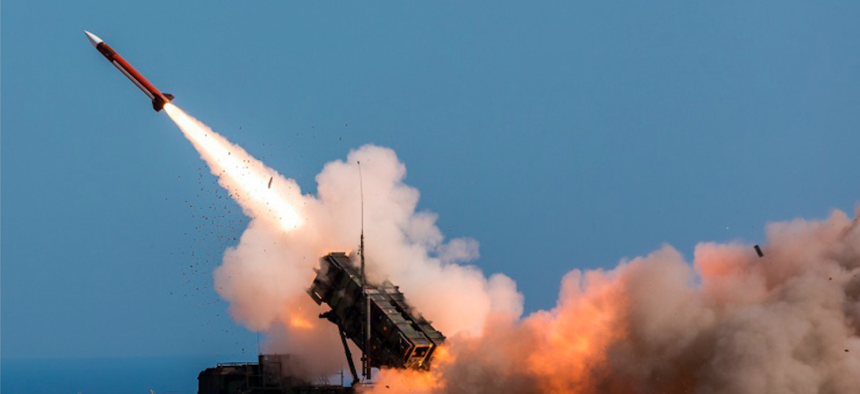
A Patriot missile is fired on Nov. 8, 2017, by German soldiers assigned to Surface Air and Missile Defense Wing 1 at the NATO Missile Firing Installation, in Chania, Greece. Sebastian Apel / U.S. Department of Defense, via AP
Did the Saudis Shoot Down a Houthi Missile on Nov. 4? It Doesn’t Much Matter
The Patriot has proven itself with dozens of successful intercepts. Moreover, it’s just one part of a solid anti-missile defense strategy.
Did Saudi forces use the U.S-made Patriot system to shoot down a Houthi missile aimed at the Riyadh airport on Nov. 4? After the Saudi Arabia Ministry of Defense claimed just that, a team of U.S. researchers cast doubt on the assertion — and suggested that it should give everyone pause about the usefulness of the anti-missile system. The researchers may (or may not) be right about the November event, but they are wrong to suggest that it should shake overall confidence in Patriot.
On Dec. 4, the New York Times published an article about research conducted by Jeffrey Lewis and a team, mostly from the Middlebury Institute of International Studies, who examined various pieces of evidence, including photos of debris, and concluded that it is unlikely the Patriot system intercepted the missile. To be sure, the article’s authors did not claim that the Saudis definitively failed to intercept the missile, and they responsibly used words like “may be wrong” and “appears to show.” Still, the article has caused some to wonder aloud whether Japan, South Korea, and other countries that host Patriot systems should worry about the reliability of the system.
Keeping in mind that no missile defense system is intended to or ever will perform with 100 percent reliability, the short answer is no.
The longer answer is this: the Patriot system is a good missile defense system and has been proven in combat. Since the Saudi-Iranian proxy war in Yemen broke out in 2015, Saudi and UAE Patriot missile defenses have intercepted at least 52 incoming missiles through Nov. 14, according to the Center for Strategic and International Studies. Patriot manufacturer Raytheon claims the actual number of intercepts is much higher: more than 100.
And it’s still possible the Saudis did, in fact, intercept the Houthi missile headed toward the capital’s airport on Nov. 5. Uzi Rubin, former head of Israel's Missile Defense Organization, believes the MIIS research team could be mistaken. Mr. Rubin wrote to me, “if the Yemeni missile was a variant of the Quiam, an Iranian-designed souped-up version of the Scud C, then it is a separating missile with a separating reentry vehicle, i.e. the front end (the "warhead") detaches itself after the end of the boost and flies on its own, while the spent stage trails behind it and hits the ground kilometers behind the warhead. If this is true, the target for the Patriots was not the missile - which by now was not a "missile" any more but two objects, a spent stage and a warhead - but just the warhead.”
This means that the intact debris in the photos posted by the New York Times may not have been the primary target of the Patriot system. The warhead would have been the primary target. The Saudis did not provide evidence of the warhead, and we simply do not know what happened to it. The only people who know whether the system really did intercept the warhead are the Saudis. People in the airport report that they felt vibrations, which could have been caused by the destruction of the warhead in the atmosphere. But as the authors of the New York Times article admit, there is no discernible damage around the airport—no craters and no scorch marks—that can be seen from satellite images that would prove the missile landed near its intended target. Mr. Lewis’s team chalks up the absence of visible damage to satellite imagery with insufficient detail to capture a crater. The other possible explanation for the absence of an image of a crater is that there is no crater.
We don’t even know what version of the Patriot the Saudis used to target the Houthi missile: the PAC-2 systems, or the more capable PAC-3s. The long-sought PAC-3s began arriving in Saudi Arabia only last summer and were not fully deployed in early November, according to a Defense News article that cites Timothy Cahill, Lockheed Martin vice president for integrated air and missile defense. This also means the Saudis might not be fully trained to use the PAC-3s, and regardless of the variant, there’s always the possibility of user error. If it was a PAC-2 that took the shot, and possibly missed, it is not an indictment of the already combat-tested PAC-2, much less the more capable PAC-3 variant.
Bottom line: other allies counting on the extra defensive capabilities of the Patriot system have ample reason to be confident in the usefulness of the system, but should never count on the system intercepting every single enemy missile. Patriot, like all other missile defense systems, is a valuable tool in a toolbox that includes a mix of offensive and defensive capabilities.
NEXT STORY: The North Korea Debate Sounds Eerily Familiar




